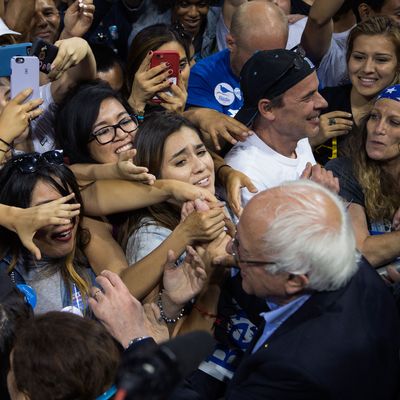
The idea that he’s fighting for an oppressed and dispossessed working class is central to Bernie Sanders’s identity as an old-school New Dealer closely aligned throughout his career with the labor movement and prone to diagnosing all the country’s problems as a product of economic inequality. Class struggle is also central to his critique of the Democratic Party as an institution that has traded its New Deal heritage of working-class solidarity — especially by promoting trade agreements and financial liberalization — for a mess of Wall Street pottage.
Indeed, some political observers have suggested that Sanders and Donald Trump represent parallel wings of a working-class uprising against political and economic elites. And Trump himself is fond of arguing that, if Bernie is denied the Democratic presidential nomination, his working-class supporters might drift over into the Trump column.
This all represents a nice, dramatic “narrative.” But the premise that Sanders is the tribune of the working class is full of very large holes.
One problem is the punditocracy’s habit of conflating “working class” with “white working class.” No one believes Sanders is sweeping the African-American or Latino working class, which matters quite a bit because those are the elements of the working class that are tangibly part of the Democratic electoral base.
But even within the “white working class,” Sanders’s support levels have been exaggerated by a failure to look at some crosscutting variables, as explained at Vox by Jeff Stein:
Because young voters also tend to have lower incomes, the massive age gap between Sanders and Clinton has sometimes looked to observers like a gap in economic class, according to political scientists Matt Grossmann and Alan Abramowitz.
But the most salient divide in the primary is not between rich and poor. It’s between young and old — and between white and black.
I’d interject here that an income-based definition of “working class” has always been problematic because earnings vary so much with age; a young college grad destined for the upper class may temporarily make less than a seasoned union member engaged in manual labor. It’s one reason most analysts use an educational definition for working class as people who do not have a college education (there’s a whole separate argument about how to classify people with “some” as opposed to no college, but let’s not go down that rabbit hole). But even an educational standard is problematic to some extent because college students don’t have a degree any more than their proletarian cousins.
As Stein shows, however, by any definition, class quickly fades as a factor in likelihood to feel the Bern as opposed to age:
If Sanders’s “white working-class” voters aren’t just college students, you’d also expect him to be doing better among downscale middle-aged white voters than rich ones.
But this turned out not to be true: Low-income white people in their 40s, 50s, 60s, and 70s did not break for Sanders. There was little difference in support by income among older voters, with higher-income older white voters actually more likely to support Sanders, according to Grossmann’s Michigan data.
“My main concern is that the image of Bernie-supporting older poor people who’ve lost their factory jobs to trade is not supported,” Grossmann says. “I’m least supportive of the idea that there’s a population of white, older workers who lost their jobs and are now supporting Sanders. There’s very little evidence of that.”
Similarly, Abramowitz ran a multivariate analysis to help figure out this question. Abramowitz looked at a large survey data set and asked: What forms of identity actually predict support for Bernie Sanders or Hillary Clinton?
“It was age, and beyond that nothing mattered. Maybe ideology mattered a little bit,” he said. Income was not a factor.
Now, maybe none of this matters and Sanders’s youth appeal indicates he’s winning the fight for the future of the party even if his claim to represent decades of working-class grievances against capitalism isn’t so clear. But at a minimum, a proper understanding of Bernie’s base should reduce fears that his following is transferable to Trump. To put it more sharply, the idea that the actual working-class voters Sanders claims to represent view Clinton as the devil isn’t borne out by the numbers. According to Andrew Levison, who’s conducted the most intensive analysis I’ve seen of the appeal of various candidates to the white working class, Sanders isn’t running that far ahead of Clinton in this demographic to begin with. And of course, if you add in the black and brown working class, any Sanders advantage disappears entirely.
Having said all this, there’s nothing wrong with a candidate’s appeal being based on age rather than class; best I can tell, no candidate has ever run up the kind of numbers among young voters in a competitive presidential nominating contest that Sanders is regularly achieving this year. It’s an impressive accomplishment with obviously large implications for the future Democratic Party. But it’s not a tale of workers rising together to shake off their chains.






























